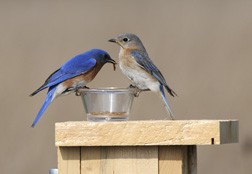Helping Bluebirds
- Share
- Tweet
- Pin
- Share

A pair of Eastern Bluebirds eagerly enjoys our handout of live mealworms. The male is on the left and female on the right. Photo by Roy Lukes.
Thoreau wrote in his journal of April 3, 1852: “The bluebird carries the sky on his back.”
Those who are so fortunate to observe our Eastern Bluebirds on a sunny day will agree with Thoreau most heartily, as they are thrilled to this rich, sky-blue elegance on the backs of these amazing birds. Those we see today or tomorrow will excite us just as much as did those last week or last year.
Helping bluebirds by building nest boxes and establishing bluebird trails began slowly as an organized program in our state around 1955. The Wisconsin DNR realized bluebird populations were declining due to severe weather and competition from non-native species. In 1986 the Bluebird Restoration Association of Wisconsin (BRAW) was formed to help increase bluebird numbers.
Today around 80 people monitor roughly 600 boxes in Door County. The top monitors are the Onsruds of Egg Harbor with 66 boxes. Regardless of whether people monitor only a small number of boxes or many, all are contributing considerably to helping the bluebirds’ fight for survival. (By the way, if you can’t monitor your boxes weekly it’s best that you don’t put up boxes at all.) Charlotte and I have been the BRAW coordinators for our county for several years, communicating, building interest, keeping records and generally helping those new to bluebirding. Reports statewide thus far indicate that 2012 may be one of the best bluebird years in a long time.
This year we observed our first bluebirds here on March 10, close to average for most years, although we’ve seen them as early as the last day of February. A very small number of these hardy birds have overwintered in the county in past years, surviving, as best we can tell, largely on dried wild grapes and juniper berries.
This year the first weekly nestbox checks of our 36 boxes was made on March 22 and, to our surprise, two already had complete nests. By April 14 there were warm eggs being incubated in several boxes. By comparison, in 2011 – which had a very cold wet spring with few to no available insects for food – the first complete nest in only one box was not until April 18.
Once a female begins incubating her clutch of eggs she must continue to do so until they hatch. Should she, for some reason or other, allow the eggs to go cold, they will not hatch. Much as it hurts us, that nest and eggs must be removed from the box or else the box will go un-used for the duration of the season. By cleaning the box out, often a new nest will be made and eggs laid. Due to temperatures below freezing on quite a few nights and early mornings in past weeks this spring, 12 of our eggs have been lost so far.
As of May 1, five of our boxes had hatched 23 eggs. We’re expecting one of our boxes having six eggs to have fledged birds by May 15. As I write this on May 2, there have been 96 eggs laid in our trail of 36 boxes which exist within a radius of two miles of our home. Only three boxes have been placed on our own land. Our trail reached 50 boxes eight years ago, but gradually has been reduced to 36, eliminating boxes that simply were not attracting bluebirds. Not that other birds, such as House Wrens and Tree Swallows, using our boxes are not good, but our goal is to attract and help Eastern Bluebirds, simple as that.
Several types of nestboxes have proven to be successful throughout North America in housing all three species, the Eastern, Western and Mountain Bluebirds. The most widely used has been the “NABS” plan developed by the North American Bluebird Association. It’s relatively easy to build and has either a front or most often a side opening. We prefer the “Kentucky” style box that basically has a top opening, which is very safe for the baby birds and easy for monitoring. I’ve modified ours to also include a side opening to simplify cleaning out the boxes immediately following each successful clutch.
Another modification I’ve made is to eliminate the use of half-inch “rebar” over which we slide the half-inch electrical conduit pipe on which the box is fastened, making it quite predator-proof. This method has led to problems, so now we use three-quarter-inch electrical conduit and no “rebar.” About four inches of one end of the three-quarter-inch pipe are flattened which makes pounding it into the ground quite easy. The house is fastened near the top of the pole, about one inch below the top of the box, by drilling through the pole and into the back of the box.
It is absolutely vital that the boxes face a large shrub or tree within preferably 10 to 30 yards, straight away from the front of the box, to which the fledglings must fly on their amazing “maiden flights.” Should the young birds land on the ground they are automatically doomed. They lack the strength needed to fly upward off the ground. Now they will become easy prey to predators.
Door County bluebirders are looking forward to a very exciting event when statewide members of BRAW will hold their annual fall gathering in Door County on September 15 at the Birch Creek Music Center. Every year our respect for this incredible group and its dedicated members grows. These worthwhile meetings are free and open to the public. The box lunch, arranged by pre-registration, will cost you $10. Details of the one-day meeting, running from 8 am – 3 pm, will be published in the group’s excellent web-site: http://www.BRAW.org.
The “guru” of Wisconsin bluebirders for the past dozen or more years, very active with BRAW, has been Dr. Kent Hall, retired biology professor from the University of Wisconsin – Stevens Point. Kent has offered several lectures and workshops in Door County in recent years and feels strongly that Door County has the makings of becoming one of the top counties in the state for developing a large bluebird population.
Join us as we work toward this worthy goal! We look forward to seeing you at the BRAW meeting this September 15. In the meantime, do all you can to help these amazing birds that carry the sky on their backs!




